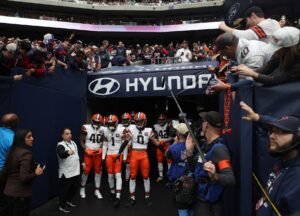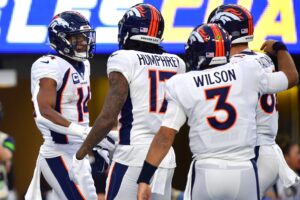Reminiscent of the story of Ahmad Bradshaw, Paul Perkins is beginning to emerge as a dominant rusher just in time for the New York Giants to clinch a playoff berth. With a win this Thursday night against the Philadelphia Eagles, the Giants could end a four-year playoff drought and secure a playoff spot for the first time since 2011. As playoff hopes are in sight, the team is in control of its own destiny and should look to seize a wildcard spot by improving its production on the offense. Getting things rolling with the run game is a necessity that needs to be accomplished quickly, because the emergence of Paul Perkins is essential for a championship run. After all, he’s the best candidate to lead the running back committee, as he’s proven in consecutive weeks by outperforming current starter Rashad Jennings.
New York Giants Running Back Paul Perkins is Essential for a Championship Run
Increased Time of Possession
Ben McAdoo is having an impressive first season as a head coach, record wise. But what the team’s record doesn’t show is the season-long struggle with effective play calling. The predictive running attempts on first down and elementary formations on the majority of offensive snaps are key factors as to why the teams ranks 27th in total offense and 30th in time of possession.
With the return of Justin Pugh at left guard last Sunday, the offense saw a boost in production as Eli Manning had more time to throw the ball. Completing 20 of 28 passes, the former Ole Miss quarterback finished the evening with 201 yards through the air and a pair of touchdowns. To compliment this, the running game contributed another 114 yards as the offensive line strengthened with the return of Pugh.
This trend for the rushing attack looks to continue into week 16 as the Giants travel to Philadelphia, where they’ll battle the Eagles who rank 17th in run defense. Paul Perkins’ ability to cut through defenders could really prove to be a challenge for Philly’s secondary, which is the weakest link of their defense.
In an earlier Week nine matchup, the Eagles defense surrendered four plays of over 25 yards, showing their vulnerability to being burned by quick players when taken to the outside. If Perkins sees more attempts in Thursday night’s primetime matchup, this weakness could benefit the Giants in ways such as increased time of possession and a worn down Eagles defense.
Assign Rashad Jennings a New Role
Looking at footage and statistics from the second half of the season, it became clear that Giants have improved significantly across almost all categories. Adjusting to a new roster and coaching staff proved to have its struggles early on, but the team seems to have overcome those obstacles, and found their groove on the field. This is undoubtedly true for the run game, which has had its fair share of various rotations and setbacks. Recently, the carries have been divided almost evenly between Rashad Jennings and Paul Perkins. In fact, over the last three games, Jennings carried the ball 39 times for 102 yards (2.6 yards/carry) while Perkins had 33 attempts for 139 yards (4.2 yards/carry). While neither player has scored a touchdown in that time span, it’s not hard to tell who the more productive back is.
Despite his struggles in the run game, all hope is not lost for Jennings. Based on rushing abilities, it has become clear he’s not the best available option, but Jennings brings something to the table that nobody else on the roster can. Pass protection. Accompanied by borderline mediocre offensive lineman, Jennings does a great job in stepping up to give Eli Manning some protection in the pocket. The veteran running back has been better known for his pass-blocking abilities than his running of the football over the years. He has a significant advantage in this skill set over his teammates, which is an important factor in why he’s kept the starting role thus far. The coaching staff needs to recognize the situation and adjust the play calling to give both Perkins and Jennings more snaps better suited to their style of play.
A potential drawback to be cautious of when doing so would be predictability. If defenses become accustomed to passing plays predominantly when Jennings is on the field or vice-versa with Perkins, they will soon be able to guess plays based on whichever rusher takes the field. To avoid this, proper execution from the coaching staff becomes a necessity. If managed effectively, the Giants will be able to open up the playbook and allow new plays and formations to be called. This not only keeps the opposing defenses guessing, it gives the Giants offense more opportunities to get a drive moving down field.
Give Eli Manning Something to Work With
Manning showed fans a glimpse of his old self with last week’s performance against the Detroit Lions. Consistently maintaining this type of output seems to be a problem, but the Giants are potentially only one week away from fixing it. Prone to sometimes blindly throwing interceptions, Manning could sure use some relief from being the one to carry the offensive unit. Assigning Perkins to the role of lead back would give the team the best chance at succeeding in the run game, something their signal caller desperately needs. With an increased chance of being able to rush for a first down, this could allow Manning to have more attempts with an open, diversified, play calling approach. This is, of course, opposed to being stuck facing second or third and long practically every time he drops back to pass.
So far this season, Giants have gone 6-1 in games where they’ve rushed for over 90 yards. The one loss, which was a result of an ugly performance consisting of three turnovers and 11 penalties for 128 yards, came against the Washington Redskins in Week three. That was 13 weeks ago and, even though the Giants are a much better team now, the game plan still should involve rushing the ball efficiently to give their quarterback and the team some momentum and field position to work with.
This strategy falls in place with coach Ben McAdoo’s “Rule of 53”. The “Rule of 53” is McAddor’s belief that when the team reaches a total of 53 combined rushing attempts and pass completions, the chances of winning the game increase. Call it what you want, but in the team’s ten wins they’ve managed to average about 50 compared to only averaging around 40 in their four losses. This proves that when both sides of the ball are able to come together, time of possession will be on their side, giving them the edge needed to win.
Main Photo






